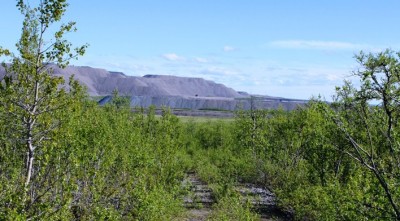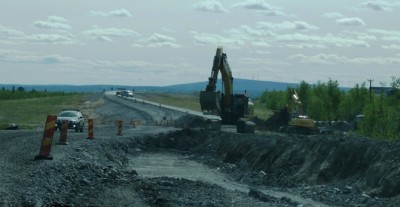I don’t know how we found ourselves there. We were exploring, and there were many old tracks to choose from. We didn’t climb any fences to get in, though we had to crawl under one to get out, so perhaps we weren’t supposed to be there.
We were near Kiruna’s copper mine (currently resting, waiting for world copper prices to rise), around the side of Kiruna’s iron ore mine that isn’t visible from the town. We could see the mine’s iron pellets factory and processing plant, and all the well-concealed associated pollution.
A lot of the area is wetlands – some of it was once part of the lake but the mining company has drained most of it away because it lies on top of the mine.
There are no buildings, no people – it’s too wet, too polluted, too generally undesirable. Or maybe it’s just that there’s too good a view of the back of the mine. Now a wind farm sells the wind energy above it, and more than one mining company have the rights to what’s underneath it.
It has a different feel to emptiness in the fjäll. Here you don’t know what underground pollutants run through the streams or are embedded in the earth, yet wildlife know it as an undisturbed area where they can hunt and breed in peace. It reminded me of film I had seen of the Chernobyl area after the disaster.
As I stopped to take a picture I caught the fast movement of a creature, perhaps a fox. Its prey was probably an arctic hare that raced by, and then sat motionless on a rock. It was the largest hare we’d ever seen. A poisoned landscape is rich and plentiful and breeds super-animals.

The area is littered with empty roads that were clearly once in regular use. Their old speed restriction signs still stand at the roadside, advising passing wildlife to slow down. The roads connect with other dirt tracks and paths, and wide, winding old tracks which are probably even older, leading nowhere in particular.
We followed one of them as it snaked up the hill through birch forest. Buzzards flew and squeaked overhead, letting us know we were invading their territory. The road wound on, and on. We had to give up in the end. It seemed to be leading us further and further away, to no identifiable destination, which was both intriguing and worrying.
Later we looked on a map and guessed the road had probably led to a disused mine. It was just an empty road leading to a hole in the ground then. The repeating story of Kiruna, drawn in the landscape.


